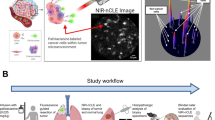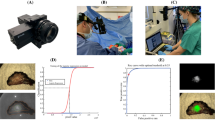Abstract
Background
We compare the application of intravenous indocyanine green (ICG) fluorescence imaging in lung cancer with near-infrared-I (NIR-I) and near-infrared-II (NIR-II) windows.
Methods
From March to December 2022, we enrolled patients who received an intravenous injection of ICG (5 mg/kg) 1 day before the planned lung cancer surgery. The lung cancer nodules were imaged by NIR-I/II fluorescence imaging systems, and the tumor-to-normal-tissue ratio (TNR) was calculated. In addition, the fluorescence intensity and signal-to-background ratio (SBR) of capillary glass tubes containing ICG covered with different thicknesses of lung tissue were measured by NIR-I/II fluorescence imaging systems.
Results
In this study, 102 patients were enrolled, and the mean age was 59.9 ± 9.2 years. A total of 96 (94.1%) and 98 (96.1%) lung nodules were successfully imaged with NIR-I and NIR-II fluorescence, and the TNR of NIR-II was significantly higher than that of NIR-I (3.9 ± 1.3 versus 2.4 ± 0.6, P < 0.001). In multiple linear regression, solid nodules (P < 0.001) and squamous cell carcinoma (P < 0.001) were independent predictors of a higher TNR of NIR-I/II. When capillary glass tubes were covered with lung tissue whose thickness was more than 2 mm, the fluorescence intensity and the SBR of NIR-II were significantly higher than those of NIR-I.
Conclusions
We verified the feasibility of NIR-II fluorescence imaging in intravenous ICG lung cancer imaging for the first time. NIR-II fluorescence can improve the TNR and penetration depth of lung cancer with promising clinical prospects.




Similar content being viewed by others
References
Gould MK, Tang T, Liu IL, et al. Recent trends in the identification of incidental pulmonary nodules. Am J Respir Crit Care Med. 2015;192(10):1208–14.
Saji H, Okada M, Tsuboi M, et al. Segmentectomy versus lobectomy in small-sized peripheral non-small-cell lung cancer (JCOG0802/WJOG4607L): a multicentre, open-label, phase 3, randomised, controlled, non-inferiority trial. Lancet. 2022;399(10335):1607–17.
Taioli E, Yip R, Olkin I, et al. Survival after sublobar resection for early-stage lung cancer: methodological obstacles in comparing the efficacy to lobectomy. J Thorac Oncol. 2016;11(3):400–6.
Aliperti LA, Predina JD, Vachani A, et al. Local and systemic recurrence is the Achilles heel of cancer surgery. Ann Surg Oncol. 2011;18(3):603–7.
Sato M. Precise sublobar lung resection for small pulmonary nodules: localization and beyond. Gen Thorac Cardiovasc Surg. 2020;68(7):684–91.
Park CH, Han K, Hur J, et al. Comparative effectiveness and safety of preoperative lung localization for pulmonary nodules: a systematic review and meta-analysis. Chest. 2017;151(2):316–28.
Okusanya OT, Holt D, Heitjan D, et al. Intraoperative near-infrared imaging can identify pulmonary nodules. Ann Thorac Surg. 2014;98(4):1223–30.
Mao Y, Chi C, Yang F, et al. The identification of sub-centimetre nodules by near-infrared fluorescence thoracoscopic systems in pulmonary resection surgeries. Eur J Cardiothorac Surg. 2017;52(6):1190–6.
He S, Song J, Qu J, et al. Crucial breakthrough of second near-infrared biological window fluorophores: design and synthesis toward multimodal imaging and theranostics. Chem Soc Rev. 2018;47(12):4258–78.
Li S, Cheng D, He L, et al. Recent progresses in NIR-I/II fluorescence imaging for surgical navigation. Front Bioeng Biotechnol. 2021;9:768698.
Cao C, Jin Z, Shi X, et al. First clinical investigation of near-infrared window IIa/IIb fluorescence imaging for precise surgical resection of gliomas. IEEE Trans Biomed Eng. 2022;69(8):2404–13.
Newton AD, Predina JD, Corbett CJ, et al. Optimization of second window indocyanine green for intraoperative near-infrared imaging of thoracic malignancy. J Am Coll Surg. 2019;228(2):188–97.
Yang W, Qin W, Hu Z, et al. Comparison of Cerenkov luminescence imaging (CLI) and gamma camera imaging for visualization of let-7 expression in lung adenocarcinoma A549 cells. Nucl Med Biol. 2012;39(7):948–53.
Cai M, Zhang Z, Shi X, et al. Non-negative iterative convex refinement approach for accurate and robust reconstruction in cerenkov luminescence tomography. IEEE Trans Med Imaging. 2020;39(10):3207–17.
Zheng S, Zhang Z, Qu Y, et al. Radiopharmaceuticals and fluorescein sodium mediated triple-modality molecular imaging allows precise image-guided tumor surgery. Adv Sci. 2019;6(13):1900159.
Zhou J, Yang F, Jiang G, et al. Applications of indocyanine green based near-infrared fluorescence imaging in thoracic surgery. J Thorac Dis. 2016;8(Suppl 9):S738-s743.
Kosaka N, Mitsunaga M, Longmire MR, et al. Near infrared fluorescence-guided real-time endoscopic detection of peritoneal ovarian cancer nodules using intravenously injected indocyanine green. Int J Cancer. 2011;129(7):1671–7.
Madajewski B, Judy BF, Mouchli A, et al. Intraoperative near-infrared imaging of surgical wounds after tumor resections can detect residual disease. Clin Cancer Res. 2012;18(20):5741–51.
Matsumura Y, Maeda H. A new concept for macromolecular therapeutics in cancer chemotherapy: mechanism of tumoritropic accumulation of proteins and the antitumor agent smancs. Cancer Res. 1986;46(12 Pt 1):6387–92.
Kennedy GT, Azari FS, Chang A, et al. Comparative experience of short-wavelength versus long-wavelength fluorophores for intraoperative molecular imaging of lung cancer. Ann Surg. 2022;276(4):711–9.
van Manen L, Handgraaf HJM, Diana M, et al. A practical guide for the use of indocyanine green and methylene blue in fluorescence-guided abdominal surgery. J Surg Oncol. 2018;118(2):283–300.
Tipirneni KE, Warram JM, Moore LS, et al. Oncologic procedures amenable to fluorescence-guided surgery. Ann Surg. 2017;266(1):36–47.
Hutteman M, Mieog JS, van der Vorst JR, et al. Randomized, double-blind comparison of indocyanine green with or without albumin premixing for near-infrared fluorescence imaging of sentinel lymph nodes in breast cancer patients. Breast Cancer Res Treat. 2011;127(1):163–70.
Ding F, Zhan Y, Lu X, et al. Recent advances in near-infrared II fluorophores for multifunctional biomedical imaging. Chem Sci. 2018;9(19):4370–80.
Shi X, Zhang Z, Zhang Z, et al. Near-infrared window II fluorescence image-guided surgery of high-grade gliomas prolongs the progression-free survival of patients. IEEE Trans Biomed Eng. 2022;69(6):1889–900.
Li C, Mi J, Wang Y, et al. New and effective EGFR-targeted fluorescence imaging technology for intraoperative rapid determination of lung cancer in freshly isolated tissue. Eur J Nucl Med Mol Imaging. 2023;50(2):494–507.
Qu Q, Nie H, Hou S, et al. Visualisation of pelvic autonomic nerves using NIR-II fluorescence imaging. Eur J Nucl Med Mol Imaging. 2022;49(13):4752–4.
Zhang Z, Fang C, Zhang Y, et al. NIR-II nano fluorescence image guided hepatic carcinoma resection on cirrhotic patient. Photodiagnos Photodyn Ther. 2022;40:103098.
Chang B, Li D, Ren Y, et al. A phosphorescent probe for in vivo imaging in the second near-infrared window. Nat Biomed Eng. 2022;6(5):629–39.
Yang J, He S, Hu Z, et al. In vivo multifunctional fluorescence imaging using liposome-coated lanthanide nanoparticles in near-infrared-II/IIa/IIb windows. Nano Today. 2021;38:101120.
Zhang L, Shi X, Li Y, et al. Visualizing tumors in real time: a highly sensitive PSMA probe for NIR-II imaging and intraoperative tumor resection. J Med Chem. 2021;64(11):7735–45.
Qu Q, Zhang Z, Guo X, et al. Novel multifunctional NIR-II aggregation-induced emission nanoparticles-assisted intraoperative identification and elimination of residual tumor. J Nanobiotechnol. 2022;20(1):143.
Chen Y, Xue L, Zhu Q, et al. Recent advances in second near-infrared region (nir-ii) fluorophores and biomedical applications. Front Chem. 2021;9:750404.
Antaris AL, Chen H, Diao S, et al. A high quantum yield molecule-protein complex fluorophore for near-infrared II imaging. Nat Commun. 2017;8:15269.
Carr JA, Franke D, Caram JR, et al. Shortwave infrared fluorescence imaging with the clinically approved near-infrared dye indocyanine green. Proc Natl Acad Sci USA. 2018;115(17):4465–70.
Hu Z, Fang C, Li B, et al. First-in-human liver-tumour surgery guided by multispectral fluorescence imaging in the visible and near-infrared-I/II windows. Nat Biomed Eng. 2020;4(3):259–71.
Hüttenberger D, Gabrecht T, Wagnières G, et al. Autofluorescence detection of tumors in the human lung–spectroscopical measurements in situ, in an in vivo model and in vitro. Photodiagnos Photodyn Ther. 2008;5(2):139–47.
Wan H, Yue J, Zhu S, et al. A bright organic NIR-II nanofluorophore for three-dimensional imaging into biological tissues. Nat Commun. 2018;9(1):1171.
Cao J, Zhu B, Zheng K, et al. Recent progress in NIR-II contrast agent for biological imaging. Front Bioeng Biotechnol. 2019;7:487.
Acknowledgment
This study was funded by National Natural Science Foundation of China (82003316, 92059203, 92059207, 62027901, 81930053, 81227901), CAS Youth Interdisciplinary Team (JCTD-2021-08), and Fundamental Research Funds for the Central Universities (JKF-YG-22-B005).
Author information
Authors and Affiliations
Corresponding authors
Ethics declarations
Disclosures
The authors declare no conflicts of interest.
Additional information
Publisher's Note
Springer Nature remains neutral with regard to jurisdictional claims in published maps and institutional affiliations.
Supplementary Information
Below is the link to the electronic supplementary material.
Rights and permissions
Springer Nature or its licensor (e.g. a society or other partner) holds exclusive rights to this article under a publishing agreement with the author(s) or other rightsholder(s); author self-archiving of the accepted manuscript version of this article is solely governed by the terms of such publishing agreement and applicable law.
About this article
Cite this article
Mi, J., Li, C., Yang, F. et al. Comparative Study of Indocyanine Green Fluorescence Imaging in Lung Cancer with Near-Infrared-I/II Windows. Ann Surg Oncol 31, 2451–2460 (2024). https://doi.org/10.1245/s10434-023-14677-9
Received:
Accepted:
Published:
Issue Date:
DOI: https://doi.org/10.1245/s10434-023-14677-9




